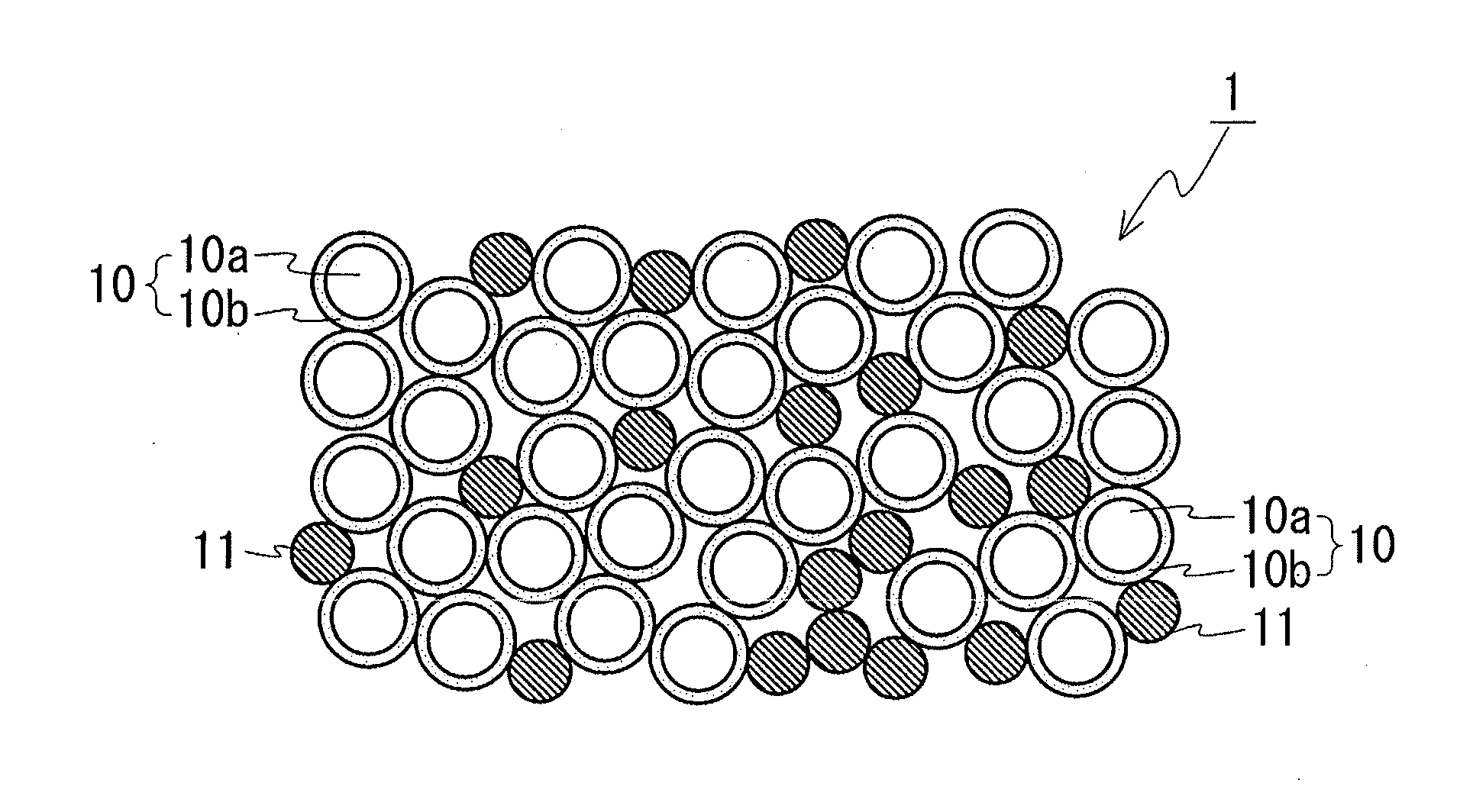Positive-electrode body for nonaqueous-electrolyte battery, method for producing the positive-electrode body, and nonaqueous-electrolyte battery
a technology of electrolyte battery and positive electrode, which is applied in the direction of non-aqueous electrolyte cells, cell components, electrochemical generators, etc., can solve the problems of inability to contact between conductive particles, and inability to achieve li-ion secondary batteries. to achieve the effect of suppressing the increase in interface resistance and enhancing the output characteristics of batteries
- Summary
- Abstract
- Description
- Claims
- Application Information
AI Technical Summary
Benefits of technology
Problems solved by technology
Method used
Image
Examples
embodiments
[Overall Configuration]
[0027]As exemplified in FIG. 2, a nonaqueous-electrolyte battery 100 according to the present invention includes a positive-electrode body 1 for a nonaqueous-electrolyte battery (positive-electrode body 1); a negative-electrode body 2; a solid-electrolyte layer 3 disposed between the electrode bodies; a positive-electrode collector 4 having a current-collecting function for the positive-electrode body 1; and a negative-electrode collector 5 having a current-collecting function for the negative-electrode body 2. The most characteristic feature of the present invention lies in the configuration of the positive-electrode body 1. Hereinafter, the configuration of the positive-electrode body 1 and a method for producing the positive-electrode body 1 according to the present invention will be first described on the basis of FIG. 1; and, subsequently, configurations other than that of the positive-electrode body 1 will be described.
[Positive-Electrode Body]
[0028]The ...
example 1
[0044]The positive-electrode body 1 was first prepared.
(1) Covering Step
[0045]Equimolar amounts of LiOEt and Nb(OEt)5 were dissolved in ethyl alcohol to prepare a precursor cover-layer solution. This precursor cover-layer solution was applied to a thickness of 8 nm on the entire surfaces of the positive-electrode active-material particles 10a constituted by a LiCoO2 powder having an average particle size of 5 μm. At this time, the precursor cover-layer solution was applied by spray-coating to the positive-electrode active-material particles 10a under ultrasonic vibration. Subsequently, ethyl alcohol serving as the solvent was evaporated to form precursor cover layers.
(2) Oxygen-Deficiency Generation Step
[0046]The positive-electrode active-material particles 10a having been covered with the precursor cover layers in the covering step were subjected to a heat treatment at 400° C. in a hydrogen-containing atmosphere having a hydrogen concentration of 100% by volume; as a result, oxygen...
example 2
[0050]The positive-electrode body 1 in EXAMPLE 2 was different from that in EXAMPLE 1 in terms of degree α of oxygen deficiency generated in the cover layers 10b. Hereinafter, this difference will be mainly described and the other configurations, which were similar to those in EXAMPLE 1, will not be described.
[0051]The positive-electrode body 1 in this EXAMPLE was different from that in EXAMPLE 1 in terms of conditions for forming oxygen deficiency in the oxygen-deficiency generation step. The positive-electrode active-material particles 10a having been covered with the precursor cover layers in the covering step were subjected to a heat treatment at 300° C. in a hydrogen-containing atmosphere having a hydrogen concentration of 50% by volume; as a result, oxygen deficiency was generated in the precursor cover layers to form the cover layers 10b. At this time, the oxygen-deficiency degree α was 0.01 and the electric conductivity was 10−5 S / cm. As in EXAMPLE 1, the electric-conductivi...
PUM
| Property | Measurement | Unit |
|---|---|---|
| Temperature | aaaaa | aaaaa |
| Temperature | aaaaa | aaaaa |
| Thickness | aaaaa | aaaaa |
Abstract
Description
Claims
Application Information
 Login to View More
Login to View More - Generate Ideas
- Intellectual Property
- Life Sciences
- Materials
- Tech Scout
- Unparalleled Data Quality
- Higher Quality Content
- 60% Fewer Hallucinations
Browse by: Latest US Patents, China's latest patents, Technical Efficacy Thesaurus, Application Domain, Technology Topic, Popular Technical Reports.
© 2025 PatSnap. All rights reserved.Legal|Privacy policy|Modern Slavery Act Transparency Statement|Sitemap|About US| Contact US: help@patsnap.com


